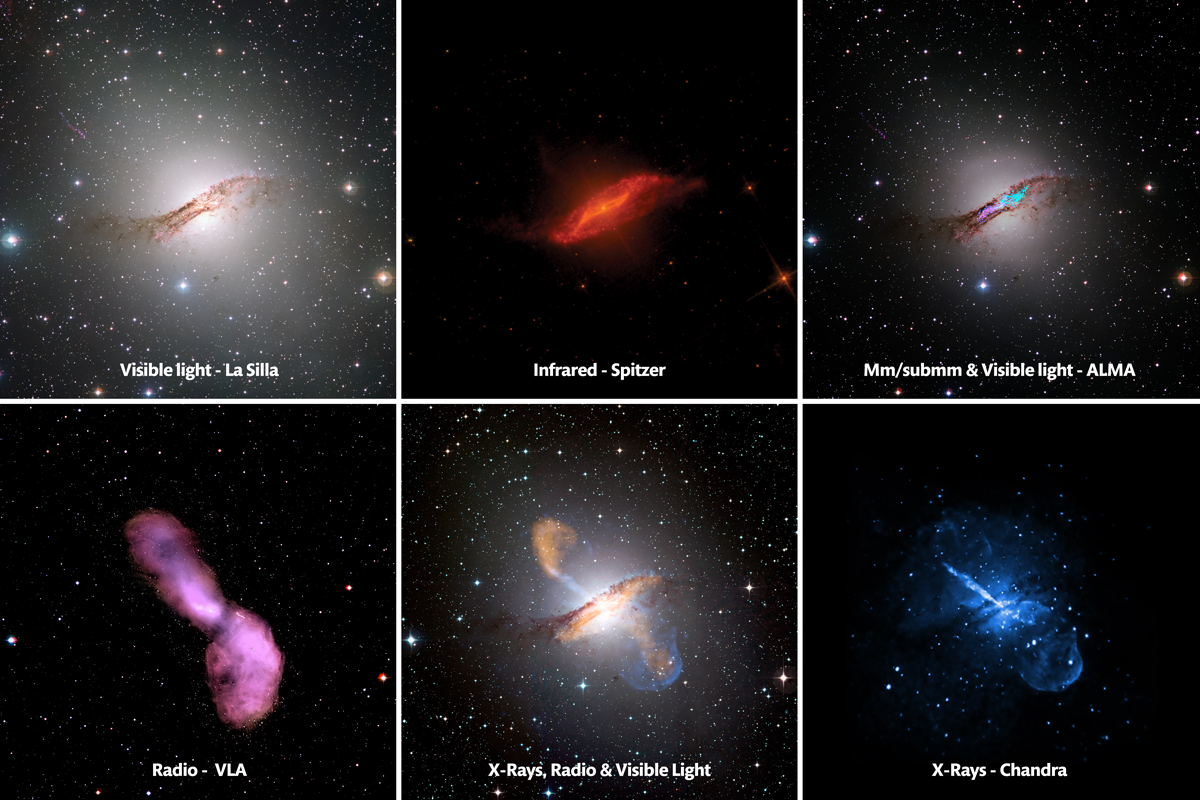How does ALMA see?
For four centuries, telescopes of all kinds have delighted us with images of the Universe that intrigue and amaze us. We have known explosions of stars, birth of planets and many other objects and phenomena. With ALMA, the mysterious light of the coldest, most hidden parts of the Universe are appearing. We can clearly observe what nobody has seen. This is the Universe of ALMA: a universe where the invisible becomes visible and where knowledge, with the help of the astronomers, is revealed to humanity.
Electromagnetic spectrum
The electromagnetic spectrum is the distribution of energies of the array of electromagnetic waves. This extends from the shortest wavelength radiation - such as gamma rays and X-rays, passing through ultraviolet, visible light and infrared rays - to the longest wavelength electromagnetic waves: the radio waves.
The physical processes that take place in the Universe emit electromagnetic radiation that can be captured with different instruments. We can use optic telescopes to capture something similar to what can be seen by the naked eye (visible light); we use space telescopes to capture gamma rays (nothing can be observed from Earth because the atmosphere blocks these rays to protect us from their high energy); and finally, we use radio telescopes to capture radio waves.
As we can observe in the images, the same object –in this case the Centaurus A galaxy–can appear differently, depending on the waves we observe. By including information from different instruments, we can obtain a much more complete image of what we are observing.

Electromagnetic spectrum
Unlike optic telescopes - like the one built by Galileo Galilei over 400 years ago- which only capture images in the visible light spectrum, radio telescopes are designed to capture radio waves emitted by sources in space. This is a segment of the electromagnetic spectrum that enables us to take a closer look at the cold Universe, as it corresponds to low-energy physical processes. Unlike the visible waves that can only be observed during the day, the radio waves can be captured 24 hours, so ALMA does not rest.
To pick up the weakest signals from the Universe we need a very large collection surface. This requires several parabolic antennas that can operate together to work as a single giant telescope. This technique is known as interferometry and enables ALMA to act as a single giant 16-km diameter telescope!
What eyes does ALMA use to observe?
Our eyes can pick up a small portion of the electromagnetic spectrum that corresponds to visible light. The Universe emits light that covers the entire spectrum just described, from radio waves to gamma waves. The studies conducted in each portion of the spectrum contribute to the knowledge of the Universe.
Thanks to ALMA, which observes the portion of the radio waves in millimetric and submillimetric wavelengths (found between the far infrared waves and the radio waves), we are able to fulfill the dream of opening a new window for high-resolution exploration of the Universe. This type of research is key to the future of astronomy, because:
- It is where the dark Universe is found
In addition to the cosmic microwave background (an almost uniform glow across the sky, a consequence of the Big Bang), the Universe emits light that we can identify in three “groupings” of energy: high energy (ultraviolet, X-ray, gamma ray and cosmic background radiation), not so high energy (visible light) and low energy (infrared, microwave and radio wave).
For four centuries, man has studied visible light emissions thanks to the use of optic telescopes. The most energetic waves are absorbed by the ozone layer and are not able to penetrate the atmosphere; therefore they must be observed with space telescopes like the Hubble. Finally, the low energy groups could not previously be observed because they were blocked by the Earth's atmosphere. However, these can now be captured by ALMA, thanks to its cutting edge technology and privileged location in the Chajnantor Plateau.
Aside from being sufficiently broad enough to house the 66 antennas, this site is also very high in altitude (5,000 meters above sea level), dry (located in the most arid desert in the world) and has the clearest skies (due to its distance from urban areas, it has less light and atmospheric pollution). This allows ALMA to capture far infrared waves.
- This gives rise to phenomena that other observatories can not witness
Some of the most persistent questions in astronomy pertain to the origin of the galaxies, stars, planets and molecules that give rise to life. ALMA observes the light emitted by cold temperature objects in space, which allows us to untangle deep mysteries about planet formation or “digital fingerprints” of complex, even organic, molecules, of which to date little, if anything, is known.
